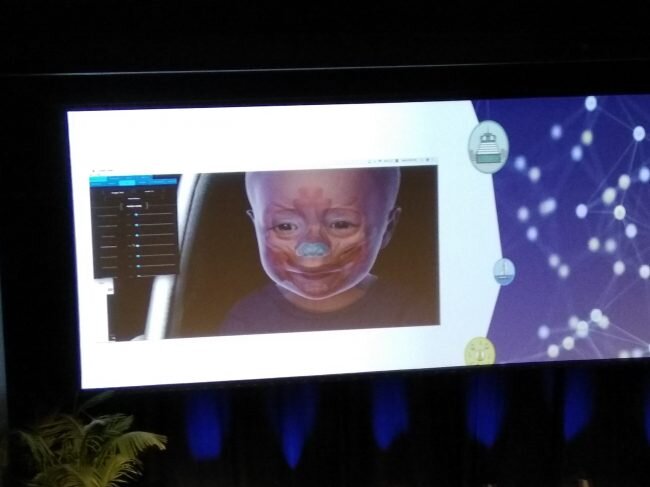AI Day Report - Vincent
Some lucky Summer of Tech students attended New Zealand's premier Artificial Intelligence Event in Auckland on 28 March. Here's a guest post from Vincent Curd from AI Day 2018:There used to be a time when talk of AI as science, not fiction, was confined to academia. Cut to 2018 and AI has driven a six-tonne autonomous Mack truck into mainstream awareness. Journalists describe it with awe and suspicion. Company executives jostle to get their heads around it. And students like me are left wondering what exactly it all means for our future.I was fortunate to get a glimpse of that future at AI Day 2018, a gathering of luminary speakers and local tech talent in Auckland last Wednesday. Thank you to Summer of Tech for the tickets! The day was a real eye-opener for me, not just with regards to AI, but also towards how vibrant and communal the NZ tech community was. I can’t do justice to the full day in just one blog post, so I’ll describe the things that stood out to me the most: the effect of AI on big tech companies, the prospect of forming human relationships with machines, and my impressions of the NZ tech industry.Start with the established tech companies like Microsoft and Google. Steve Guggenheimer, a Vice President at Microsoft, opened the day by giving his rundown on how AI was changing his company. AI was one of three key technologies Microsoft was betting would make waves within the tech world, alongside ‘mixed realities’ (think VR and AR) and quantum computing. Interestingly, although tech giants have the most well-resourced and perhaps advanced AI projects, they also stand to lose the most. Digital personal assistants like Siri and Alexa are good examples of how more of our interactions with computers are conducted with voice, rather than by screen. Companies that make the vast majority of their profits from advertising, such as Google and Facebook, may find it harder to serve ads to users via voice. Expect the business model of many digital giants to change over the near future.The second big thing that stood out to me was the extent to which AI was being made to feel human. This began with a talk from Adam Cutler, a distinguished designer at IBM. Adam’s job was to design machines that people could form meaningful relationships with. To accomplish that, he looked at how humans form relationships with each other. Using psychological models that broke down relationship-building into sequential steps such as ‘initiating’, ‘intensifying’ and ‘bonding’, Adam’s work attempted to replicate each step with a machine. Setting up a computer in the future may not be as simple as unboxing it and plugging it into a wall. Expect to grow a relationship with it, somewhat like how you would acquire a friend or confidant. It will start with the human-to-machine equivalent of small talk: taking care of small, transactional parts of your life such as scheduling appointments. As the machine learns more about you and tailors the way it presents information to you, you may well feel like you are working with a trusted advisor who knows how your life works on an instinctive level. That in turn could encourage you to open up more, entrusting the machine with more of your life and letting it embed itself deeper into your existence. In many respects this is an extension of our relationship with search engines. It’s not uncommon for people to type things into Google that they wouldn’t share with their psychiatrist, their friends, or their partner. This kind of intimacy with machines has already been breached – all that remains is for the machines to be given a more human face.Speaking of human faces, the last speech of the day was given by Greg Cross and Dr Mark Sagar from Soul Machines, a high-flying New Zealand company creating digital visualisations of human faces. Their facial expressions, their mannerisms – in short, everything that made them feel human – was autonomous. That means they weren’t explicitly programmed or scripted by humans. Deep learning algorithms had ‘learnt’ in which situations to deploy certain facial expressions, or to adopt a particular tone of voice. This was shown to us in a live demonstration of ‘Baby X’: a simulated baby that responded appropriately to various stimuli: face lighting up when a familiar, trusted human entered the webcam’s range of vision, tears starting to well when exposed to something distressing, like a sudden loud noise.
Setting up a computer in the future may not be as simple as unboxing it and plugging it into a wall. Expect to grow a relationship with it, somewhat like how you would acquire a friend or confidant. It will start with the human-to-machine equivalent of small talk: taking care of small, transactional parts of your life such as scheduling appointments. As the machine learns more about you and tailors the way it presents information to you, you may well feel like you are working with a trusted advisor who knows how your life works on an instinctive level. That in turn could encourage you to open up more, entrusting the machine with more of your life and letting it embed itself deeper into your existence. In many respects this is an extension of our relationship with search engines. It’s not uncommon for people to type things into Google that they wouldn’t share with their psychiatrist, their friends, or their partner. This kind of intimacy with machines has already been breached – all that remains is for the machines to be given a more human face.Speaking of human faces, the last speech of the day was given by Greg Cross and Dr Mark Sagar from Soul Machines, a high-flying New Zealand company creating digital visualisations of human faces. Their facial expressions, their mannerisms – in short, everything that made them feel human – was autonomous. That means they weren’t explicitly programmed or scripted by humans. Deep learning algorithms had ‘learnt’ in which situations to deploy certain facial expressions, or to adopt a particular tone of voice. This was shown to us in a live demonstration of ‘Baby X’: a simulated baby that responded appropriately to various stimuli: face lighting up when a familiar, trusted human entered the webcam’s range of vision, tears starting to well when exposed to something distressing, like a sudden loud noise. That was just the tip of the iceberg though. Peel back the skin (as was dramatically done on stage) and you’ll discover that not only were the facial expressions simulated, the muscles controlling those facial expressions were also stimulated.
That was just the tip of the iceberg though. Peel back the skin (as was dramatically done on stage) and you’ll discover that not only were the facial expressions simulated, the muscles controlling those facial expressions were also stimulated. It didn’t stop there. Soul Machines’ team had managed to simulate everything right down to the nervous system. Muscles parted to reveal a brain perched atop a glowing mass of nerve cells, tubes pulsing with light as the body responded to various stimuli.
It didn’t stop there. Soul Machines’ team had managed to simulate everything right down to the nervous system. Muscles parted to reveal a brain perched atop a glowing mass of nerve cells, tubes pulsing with light as the body responded to various stimuli. The implications of this took a while to sink in. Simulating facial expressions to respond to complex social cues was impressive enough, but more than just that, the entire nervous system’s response was mapped. A working model of how humans respond to and engage with social stimulus right down to our neural impulses had been created. “Our creations will give digital assistants (think Siri and Alexa) a human face,” Greg Cross said. “They will be to digital assistants what TV was to radio.” Staring into Baby X’s uncannily-lifelike face, It was hard to disagree.The day ended with drinks, nibbles and a chance to chat with speakers and fellow conference attendees. What struck me the most here, and what was perhaps the most marvellous thing about the whole conference, was how convivial my fellow attendees were. They were a microcosm of New Zealand’s tech community, a collection of software engineers, managers, marketers, directors and many others from nearly all major NZ tech companies, as well as smaller companies and freelancers. I got the impression that the NZ tech community was a really nice place to be. People were more than willing to pass on advice to myself and other student attendees. Everyone seemed to know each other and there was a real sense of camaraderie, as if we were all building New Zealand’s high-tech scene into something exciting together. Or like we were a tight-knit crew of entrepreneurs, all working in the same garage. “Tech in New Zealand has two degrees of connection,” a kiwi expat now living in Silicon Valley told me. “That means things move faster here. You can get things done.”AI day gave me plenty to think about. Visions of our future with AI are often nebulous. AI Day gave shape to some of that uncertainty. But more than that, it gave me optimism that whatever the future holds, the energy and innovation of the NZ tech community will sculpt it into something inspiring. These are exciting times to be a tech student.
The implications of this took a while to sink in. Simulating facial expressions to respond to complex social cues was impressive enough, but more than just that, the entire nervous system’s response was mapped. A working model of how humans respond to and engage with social stimulus right down to our neural impulses had been created. “Our creations will give digital assistants (think Siri and Alexa) a human face,” Greg Cross said. “They will be to digital assistants what TV was to radio.” Staring into Baby X’s uncannily-lifelike face, It was hard to disagree.The day ended with drinks, nibbles and a chance to chat with speakers and fellow conference attendees. What struck me the most here, and what was perhaps the most marvellous thing about the whole conference, was how convivial my fellow attendees were. They were a microcosm of New Zealand’s tech community, a collection of software engineers, managers, marketers, directors and many others from nearly all major NZ tech companies, as well as smaller companies and freelancers. I got the impression that the NZ tech community was a really nice place to be. People were more than willing to pass on advice to myself and other student attendees. Everyone seemed to know each other and there was a real sense of camaraderie, as if we were all building New Zealand’s high-tech scene into something exciting together. Or like we were a tight-knit crew of entrepreneurs, all working in the same garage. “Tech in New Zealand has two degrees of connection,” a kiwi expat now living in Silicon Valley told me. “That means things move faster here. You can get things done.”AI day gave me plenty to think about. Visions of our future with AI are often nebulous. AI Day gave shape to some of that uncertainty. But more than that, it gave me optimism that whatever the future holds, the energy and innovation of the NZ tech community will sculpt it into something inspiring. These are exciting times to be a tech student.
